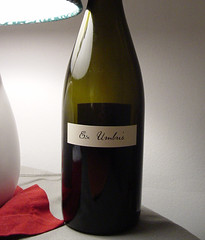
Tonight I thought I'd treat myself to something I'd been anxious to try since it arrived in our store last week: Owen Roe Ex Umbris Syrah 2006 from the Columbia Valley in Washington State. I have a particular fondness for syrah, and the wine's distributor, Polaner Selections, packs a consistently compelling portfolio of sensational wines. The bottle's heft, combined with its austere minimalist design is sure to intrigue people like myself. With grapes blended from several different vineyards, clearly a great deal of thought went into this wine (note: apparently the fruit is harvested from Washington state, but the wine is produced in Oregon...curious) . In particular, the winemaker's notes emphasize the importance of terroir by noting the raging wildfire which swept through areas adjacent to one of the vineyards. Apparently past vintages (and especially the first) displayed extraordinary smokey qualities as a result of the proximity of the fires (
click here for vintner's description). Each year since then has yielded consistently less smoke. And so at 2006, with this purportedly smokey wine in my hands, I am a trifle disappointed to find much more fruit than smoke upon whiffing, tasting, and whiffing again this wine. Latin for "from the shadows," Ex Umbris does, however, deliver in the flavor department, with a grand richness that definitely took some finesse from the winemaker.

Planned in advance, I had decided to cook lamb tonight, as a tribute to this syrah. As it turned out, the two went together in a delightful synergy of sweet spice and game. Spiced lamb chops with chick pea salad served well alongside this rich creamy red. The dominant flavor of strawberry preserves cut through the sweet spice of lamb and raw garlic in the salad. In addition, the rich, buttery texture of the wine provided greater fulfillment in an otherwise lighthearted meal. Towards the middle of the bottle, a strong semblance of bacon fat makes itself known among strawberry fields and blueberries in whipped cream. However, the ripe red berries tend to overwhelm the spicy characteristics of this wine, leaving me a little befuddled by the description. Perhaps Owen Roe should have taken a closer taste before slapping this promise of smoke on the back of the bottle. While I was expecting something closer to a French Hermitage, I did enjoy the wine, despite its very New Worldly demeanor. All in all, a recommended good value, but I give it a 91/100 for a slightly misleading description.
Tasting Summary:
Name: Owen Roe Ex Umbris Syrah 2006
From: Columbia Valley, Washington. USA.
Year: 2006
Grapes: 100% Syrah (from 3 different vineyards)
A thick ruby red color, Ex Umbris displays prominent aromas of strawberry preserves, blueberries, vanilla, and bacon fat. On the palate, berries and cream glide along the tongue, escorted by mild mannered silk-laden tannins. While an initial acidity defines the fruit, oak and vanilla mellow this full-bodied syrah until it concludes with a long fermata of cinnamon and a toasty encore of warm berry compote. With food, the sweet bacon-like smoke is unveiled, stirring thoughts of autumn leaves. Definitely a New World syrah with mild tannins, yet held together by a decadent buttery richness. Unexpected but unforgettable.
Note: This wine would definitely benefit from some breathing time. Decanting may be a little drastic, as the acidity could be lost through excessive exposure to oxygen. Bottom line, swirling the glass is your best bet.
Spiced lamb chops and chick pea salad:Serves 2Marinade:
1 tablespoon cumin
1 tablespoon ground coriander
1 teaspoon paprika
1 tablespoon ground pepper
2 bay leaves, crushed
1 teaspoon dried oregano
1 teaspoon dried basil
1 teaspoon dried or fresh rosemary and/or thyme
4 lamb loin chops
For the salad:
1 15-ounce can chickpeas, drained and rinsed
4 plum tomatoes, seeds removed, diced
1 teaspoon dried basil
1 teaspoon dried Greek oregano
1/2 cucumber, seeds removed, diced
1/2 cucumber, peeled, sliced thin
1/8 cup fresh mint leaves, chopped
1 handful mixed greens
2 teaspoons white wine vinegar
1 clove garlic, crushed into a paste
5 tablespoons olive oil
Zest of 1 lemon, grated
3 tablespoons fresh lemon juice
1 teaspoon kosher salt
1/2 teaspoon black pepper
One night before, combine cumin, coriander, paprika, bay leaves, dried herbs and pepper with oil and 1/4 cup red wine if you have it. Mix well and coat the lamb chops. Seal in airtight container for the following day. If you don't have the time, simply marinate for a half hour, or make a dry spice rub by omitting the oil and wine. Just be careful not to overseason the lamb.
Using the side of the knife, along with a healthy pinch of salt, scrape the crushed garlic against the cutting board until a paste-like consistency is achieved. In a large bowl, combine the chickpeas, tomatoes, cucumber, dried herbs, mint, vinegar, garlic, 3 tablespoons of the oil, the lemon zest and juice, 1/2 teaspoon of the salt, and 1/4 teaspoon of the pepper; set aside to marinate.
Sprinkle some salt and fresh ground pepper on both sides of the lamb chops, and heat 1 tablespoon oil in a skillet over medium-high heat. Add lamb chops to the skillet. Cook to the desired doneness, 2 to 3 minutes per side for medium-rare. Transfer to a plate. Arrange sliced cucumber around sides of plate, spoon chickpea salad in the middle with mixed greens (tossed in the chickpea salad marinade), and top each salad with 2 lamb chops.
Pour some wine and enjoy! Finish the meal with some cheese and chocolate for a decadently appropriate touch.
(N.B. Original recipe courtesy
Fresh Direct. Modified to suit my taste and availability of ingredients.)













